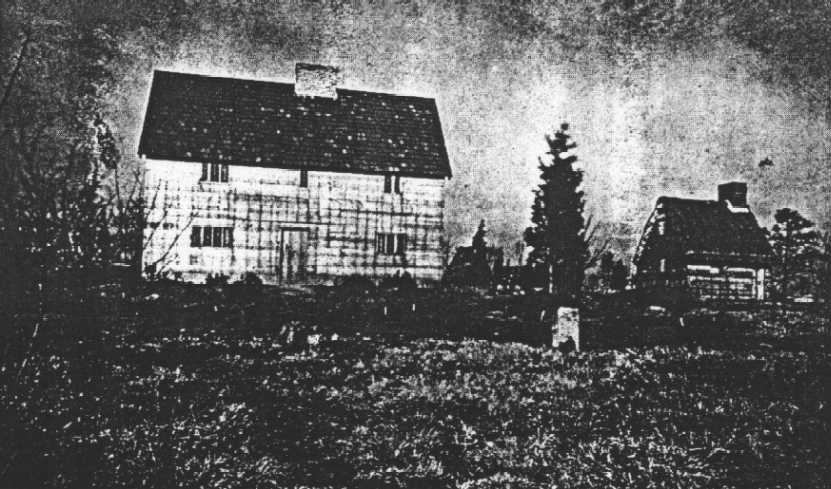
This was a full size reproduction of the ship
Arbella, made in 1930 to celebrate the 300th anniversary of the arrival of
the Winthrop fleet in Salem, MA. The pictures and article following are from
"Old=Time New England", The Bulletin of The Society for the Preservation
of New England Antiquities. This was "A QUARTERLY MAGAZINE DEVOTED TO
THE ANCIENT BUILDINGS, HOUSEHOLD FURNISHINGS, DOMESTIC ARTS, MANNERS AND
CUSTOMS, AND MINOR ANTIQUITIES OF THE NEW ENGLAND PEOPLE"; Volume XXII; JULY,
1931; Number I.
The title was: The Colonial Village Built
at Salem, Mass, in the Spring of 1930, by George Francis Dow.
DURING the year 1930, Massachusetts celebrated
the tercentenary of the arrival of the fleet under Governor John Winthrop,
which reached Salem on June 12, 1630. This was a celebration of the three-hundredth
anniversary of the settlement of Boston, in fact, but the State and many cities
and towns sezed upon the anniversary as a suitable occasion for celebrating
the tercentenary of the founding of the colony in the Massachusetts Bay..
These celebrations varied greatly in character. There were the customary addresses
and processions with floats exhibiting historical episodes. There was also
much display of pageantry, placing monuments and marking historic buildings
and sites. Historical compilations and souvenir volumes were printed
and the newspapers and periodicals published much relevant matter.
In Salem, the seaport where the Winthrop fleet came
to anchor, the celebration of this anniversary took the form of an attempt
to reproduce the landing from the Winthrop flagship, the Arbella, and the
reconstruction of the small collection of dwellings built by John Endecott
and his followers and found there by the newcomers.
The first Europeans to settle at Salem were fishermen
sent over to Cape Ann in 1624, but the fishing settlement proving a failure,
Conant, Woodbury, Palfrey, Balch, and others of the company, in 1626, removed
to Salem, then called by the Indians "Naumkeag," and were living there when
Capt. John Endecott arrived in September, 1628, sent out by the company of
the Massachusetts Bay in New England. It is not known how many "Old Planters"
were living in Naumkeag when Captain Endecott arrived, but the combined settlement
is thought to have comprised about sixty persons. The next year (1629) a
charter was granted to the Company by King Charles I, and Endecott was then
elected resident governor. A copy of the charter was sent over to Captain
Endecott, with a notice of his election as governor, and with it came an
emigration of about two hundred persons, in charge of Rev. Francis Higginson
and the Rev. Thomas Skelton. During the succeeding winter there was much
sickness and many deaths, and when Governor John Winthrop,. who had been
elected governor, superseding
Endecott, arrived on June 12, 1630, with twelve vessels, bringing about three
hundred passengers, he found a greatly weakened colony with food supplies
sufficient for only two or three weeks. Even the Indians had found the preceding
winter most severe and had been forced to live in part upon ground acorns.
Edward Johnson, the town clerk of Woburn, has described
the colonists as "feeding on fancies with new discoveries at the Spring's
approach, while they made shift to rub out the Winter's cold by the Fire-Side,
having fuell enough growing at their very doores, turning down many a drop
of the Bottell and burning Tobacco with all the ease they could, discoursing
between one while and another, of the great progresse they would make after
the Summer's-Sun had changed the earthe's white-furr'd Gowne into a greene
Mantle."
In 1629, the Rev. Francis Higginson had written:
"We that are settled at Salem make what haste we can to build houses, so that
within a short time we shall have a faire towne." It is the kind of structure
erected at that time that Salem aimed to reproduce in 1930. It is well known
from contemporaneous evidence that Capt. John Endecott, upon his arrival,
had floated up from Cape Ann a frame house that had been erected there for
use at the fishing settlement. This seems to have been the best house in
the infant settlement, as the early cabins and cottages built by the fishermen
from Cape Ann, along the shore of the North River in Salem, had all disappeared
by 1661.
Their principal settlement was near the foot of
what is now Skerry Street, and the "Planters' Marsh," from which they obtained
the thatch to roof their cottages, lay to the eastward, across what is now
Bridge Street. Captain Endecott located his "fayre house," brought from Cape
Ann, also on the North River, not far from the northerly end of the present
railroad tunnel. This building had disappeared before the end of the century
and the reproduction, built in the spring of 1930, copies the oldest known
frame house now standing in Massachusetts - the Fairbanks house built at
Dedham, probably in 1637.

The Governor's "Fayre House"
Continued on Page 2.
Back to Winthrop Fleet and John 1
Bigelow.
Back to Winthrop History
Information on these pages provided by:
Gerald G. Johnson, Ph.D.
648 Salem Heights Avenue, So.
Salem, OR 97302-5613
(503) 371-9485
gerrygarth@earthlink.net

